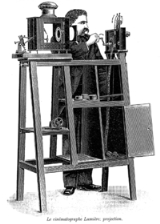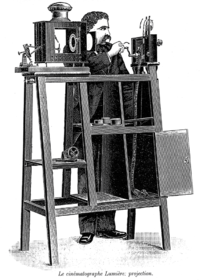
Cinematographe
Encyclopedia

Camera
A camera is a device that records and stores images. These images may be still photographs or moving images such as videos or movies. The term camera comes from the camera obscura , an early mechanism for projecting images...
, which also serves as a film projector
Film projector
Film projection or Film projector may refer to:*Movie projector for projection of moving images from film*Slide projector for projection of still images from film...
and developer. It was invented in the 1890s
1890s
The 1890s were sometimes referred to as the "Mauve Decade" - because William Henry Perkin's aniline dye allowed the widespread use of that colour in fashion - and also as the "Gay Nineties", under the then-current usage of the word "gay" which referred simply to merriment and frivolity, with no...
.Note that this was not the first 'moving picture' device. Louis Le Prince
Louis Le Prince
Louis Aimé Augustin Le Prince was an inventor who is considered by many film historians as the true father of motion pictures, who shot the first moving pictures on paper film using a single lens camera....
had built early devices in 1886. His 1888 film Roundhay Garden Scene
Roundhay Garden Scene
Roundhay Garden Scene is an 1888 short film directed by inventor Louis Le Prince. It was recorded at 12 frames per second, runs for 2.11 seconds and is the oldest surviving film.-Overview:...
still survives.
There is much dispute as to the identity of its inventor. Some argue that the device was first invented and patented as "Cinématographe Léon Bouly" by French inventor Léon Bouly
Léon Bouly
Léon Guillaume Bouly was a French inventor who created the word cinematograph.-Cinematograph:After devising chronophotography devices, Bouly applied a patent on a reversible device of photography and optics for the analysis and synthesis of motions, calling it the Cynématographe Léon Bouly on...
on February 12, 1892. It is said that, due to a lack of fee, Bouly was not able to pay the rent for his patent the following year, and Auguste and Louis Lumière
Auguste and Louis Lumière
The Lumière brothers, Auguste Marie Louis Nicolas and Louis Jean , were among the earliest filmmakers in history...
's engineers bought the license.
Popular thought, however, dictates that Louis Lumière was the first to conceptualise the idea, and both Lumière brothers shared the patent. They made their first film, Sortie de l'usine Lumière de Lyon
Workers Leaving the Lumiere Factory
Workers Leaving The Lumière Factory in Lyon Workers Leaving The Lumière Factory in Lyon Workers Leaving The Lumière Factory in Lyon (also known as La Sortie des usines Lumière à Lyon (original title), Employees Leaving the Lumière Factory and Exiting the Factory (US titles) is an 1895 French short...
, in 1894. The film was publicly screened at L'Eden, the world's first and oldest cinéma, located in La Ciotat
La Ciotat
La Ciotat is a commune in the Bouches-du-Rhône department in the Provence-Alpes-Côte d'Azur region in southern France. It is part of the metropolitan area of Marseille Provence. La ciotat is located to the east of Marseille at an equal distance from Marseille and Toulon...
in southeastern France, on September 28, 1895. The first commercial, public screening of cinematographic
Cinematography
Cinematography is the making of lighting and camera choices when recording photographic images for cinema. It is closely related to the art of still photography...
films happened in Paris on 28 December 1895 and was organised by the Lumière brothers
Auguste and Louis Lumière
The Lumière brothers, Auguste Marie Louis Nicolas and Louis Jean , were among the earliest filmmakers in history...
.

See also
- BiographAmerican Mutoscope and Biograph CompanyThe American Mutoscope and Biograph Company, was a motion picture company founded in 1895 and active until 1928. It was the first company in the United States devoted entirely to film production and exhibition, and for two decades was one of the most prolific, releasing over three thousand short...
- ElectrotachyscopeElectrotachyscopeThe électrotachyscope is an 1887 invention of Ottomar Anschütz of Germany which presents the illusion of motion with transparent serial photographs, chronophotographs, arranged on a spinning wheel of fortune or mandala-like glass disc, significant as a technological development in the history of...
- ImageImageAn image is an artifact, for example a two-dimensional picture, that has a similar appearance to some subject—usually a physical object or a person.-Characteristics:...
- KinetoscopeKinetoscopeThe Kinetoscope is an early motion picture exhibition device. Though not a movie projector—it was designed for films to be viewed individually through the window of a cabinet housing its components—the Kinetoscope introduced the basic approach that would become the standard for all cinematic...
- List of film formats
- Panoptikon
- PleographPleographPleograph was an early type of movie camera constructed in 1894, before those made by the Lumière brothers, by Polish inventor Kazimierz Prószyński. Prószyński later constructed the first hand held camera called an Aeroscope....
- PraxinoscopePraxinoscopeThe praxinoscope was an animation device, the successor to the zoetrope. It was invented in France in 1877 by Charles-Émile Reynaud. Like the zoetrope, it used a strip of pictures placed around the inner surface of a spinning cylinder...
- VitascopeVitascopeVitascope was an early film projector first demonstrated in 1895 by Charles Francis Jenkins and Thomas Armat. They had made modifications to Jenkins patented "Phantoscope", which cast images via film & electric light onto a wall or screen...
- ZoopraxiscopeEadweard MuybridgeEadweard J. Muybridge was an English photographer who spent much of his life in the United States. He is known for his pioneering work on animal locomotion which used multiple cameras to capture motion, and his zoopraxiscope, a device for projecting motion pictures that pre-dated the flexible...
- FilmFilmA film, also called a movie or motion picture, is a series of still or moving images. It is produced by recording photographic images with cameras, or by creating images using animation techniques or visual effects...

